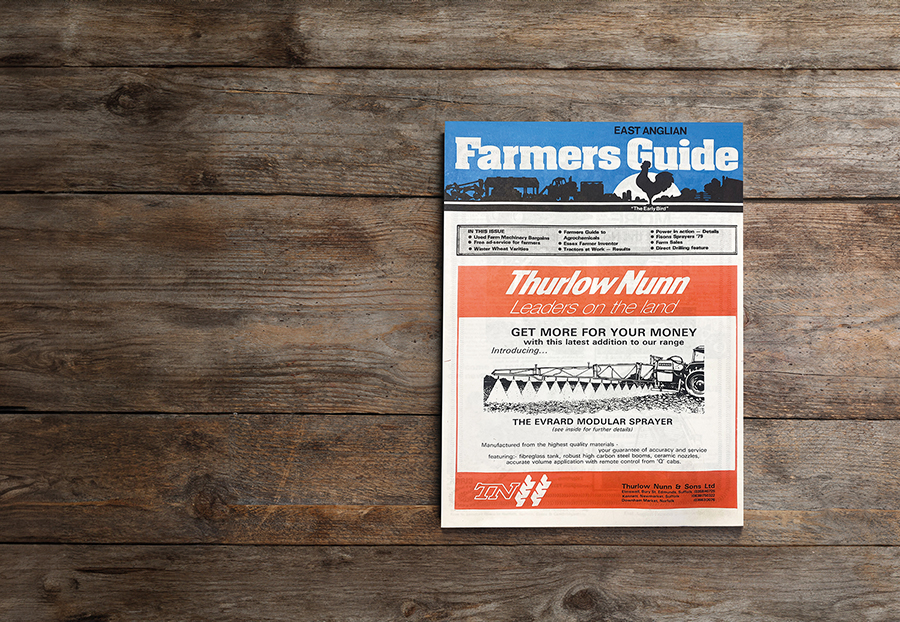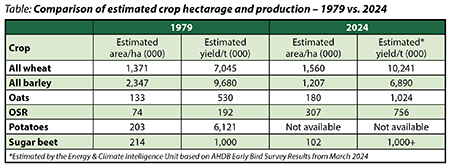In 45 years of farming: How much has it really changed?
31st August 2024
This month, Farmers Guide celebrates 45 years of supporting British farmers, with the first ever issue of the magazine published being September 1979. Rachel Hicks looks back at arable cropping across the UK then, versus now.

1979 – the golden days?
According to the government’s Annual Review of Agriculture 1980, which analysed the 1979 farming situation, the weather in the early part of 1979 was “particularly severe” and there was a cold, wet spring.
The price of the industry’s inputs increased by 13%, but this was not matched by output prices.
Cereal yields, particularly wheat, were “generally high” with total grain production expected to reach a new record level at the time.
In 1979, cereals were grown on some 3.87 million hectares, with grain production predicted to reach 17.3 million tonnes – around 73,000t above the previous year’s figure.
The report stated that good sowing conditions in 1978 had led to an increase in the wheat area, at the expense of oats and grassland.
The harvest was generally later than usual, with wheat yields generally being high – particularly for wheat – but the crop quality was variable.
A record oilseed rape crop of 192,000 tonnes, around 25% higher than 1978, was predicted, with a total of 74,000ha in the ground and good yields.
Potato planting was very late in some parts of the country; around 203ha of potatoes were planted, and while yields were lower than the high levels seen in 1978, the report indicated that supply should be adequate to meet demand.
The expectation was that the area of sugar beet harvested would increase again, as per previous years, with the possibility of a record crop being achieved. For 1979, British Sugar had contracted to purchase the beet from 217,000ha, with around 212,000ha expected to be harvested, compared to 205,000ha in 1978. The report suggested the crop should yield over 1 million tonnes of white sugar, assuming no disruption due to weather, which could rival the previous record of 1.086M tonnes in 1971.
2024 – how does it compare?
2023/2024 saw the wettest 18 months in the UK, since records began in 1836.
As such, it’s no surprise that AHDB’s annual Variety & Planting Survey, published in July 2024, indicated a significant reduction in the total wheat area planted. The estimate is around 1.56 million ha, which is the second smallest planted area since 1981, behind only 2020.
The total barley area is reportedly up by 6% on 2023, at 1.207M ha – although this is only 1% up on the five-year average.

Unsurprisingly, the spring barley area rose considerably by 18% to an estimated 804,000ha – the third largest area since the turn of the century, with winter barley falling 12% as a result of the poor weather conditions in the autumn.
The OSR area is estimated at 307,000ha – a decline of 21% year-on-year, and the second lowest area in the last 20 years. In addition to the challenging winter weather, OSR remained under pressure from cabbage stem flea beetle. Also, margins have been tightened this year as the crop’s value has depreciated considerably since 2022.
Potato planting was delayed by more than six weeks for many areas, particularly for earlies, due to the constant wet weather and resulting poor field conditions, along with the low soil temperatures. Tight supply of seed potatoes in the UK and Europe caused further problems, limiting hectarage.
There is also a high risk of virus issues carrying over from last year, due to some crop not being lifted due to the poor harvest conditions in 2023 combined with some growers resorting to cutting farm-saved potatoes in half for seeding. No expected growing area has been declared to date but it is likely to be significantly down on previous years.
2023 was a difficult year for sugar beet, with the wet weather and flooding meaning a lot of the crop was still to be harvested during the first part of 2024. However, the 2024 campaign has been more positive. According to British Sugar’s agriculture director, Dan Green: “This year’s sugar beet crop has been growing well over the summer and is likely to be around 102,000ha. The crop is benefitting from the recent warmer temperatures, and we expect to see some good yields and good margins for our growers.”
While weather in the 2023/2024 season played a large part in the cropping decisions made on-farm, there is also a notable rise in the area left fallow, with growers switching land into agri-environment schemes under the Sustainable Farming Incentive.
Of course, one thing that has remained the same during the entire 45 years is Farmers Guide’s free FarmAds. The first FarmAds form appeared in the September 1979 issue, and it’s featured in every issue since – providing farmers with a free platform to sell their second-hand kit and machinery. But now, farmers can also upload listings online too – visit www.farmads.co.uk to register and start listing your used machinery for free.
Read more arable news


